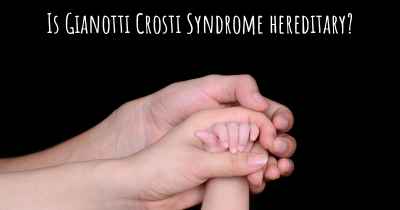Living with Gianotti Crosti Syndrome. How to live with Gianotti Crosti Syndrome?
Can you be happy living with Gianotti Crosti Syndrome? What do you have to do to be happy with Gianotti Crosti Syndrome? Living with Gianotti Crosti Syndrome can be difficult, but you have to fight to try to be happy. Have a look at things that other people have done to be happy with Gianotti Crosti Syndrome

Living with Gianotti Crosti Syndrome
Gianotti Crosti Syndrome (GCS), also known as papular acrodermatitis of childhood, is a rare skin condition that primarily affects children between the ages of 6 months and 14 years. While the exact cause of GCS is unknown, it is believed to be triggered by certain viral infections, such as hepatitis B or Epstein-Barr virus. Living with GCS can be challenging, but with proper care and management, individuals can lead a fulfilling life.
1. Seek Medical Advice
If you or your child has been diagnosed with GCS, it is crucial to consult with a dermatologist or a healthcare professional experienced in treating this condition. They can provide you with accurate information, guidance, and a personalized treatment plan based on the severity of the symptoms.
2. Understand the Symptoms
GCS is characterized by a distinctive rash that typically appears on the face, buttocks, and extremities. The rash consists of small, red or flesh-colored bumps that may be itchy or tender. Other symptoms may include fever, fatigue, and swollen lymph nodes. It is important to be aware of these symptoms to monitor the progression of the condition and seek medical attention if necessary.
3. Practice Good Hygiene
Maintaining good hygiene is essential for managing GCS. Regularly wash the affected areas with mild soap and lukewarm water. Avoid using harsh or scented products that may irritate the skin further. Gently pat the skin dry with a soft towel and avoid rubbing or scratching the rash, as it can lead to secondary infections.
4. Moisturize the Skin
Keeping the skin well-moisturized can help alleviate discomfort and reduce the appearance of the rash. Use fragrance-free moisturizers or emollients recommended by your healthcare professional. Apply them generously to the affected areas after bathing or whenever the skin feels dry.
5. Avoid Triggers
While the exact triggers for GCS are unknown, it is believed that certain viral infections can initiate the condition. Take precautions to minimize exposure to potential triggers, such as practicing good hand hygiene, avoiding close contact with individuals who have viral infections, and maintaining a healthy lifestyle to boost the immune system.
6. Manage Itchiness
Itchiness is a common symptom of GCS and can be quite bothersome. To manage itchiness, avoid scratching the rash and consider using over-the-counter antihistamines or topical corticosteroids as recommended by your healthcare professional. Additionally, keeping the skin cool and wearing loose-fitting clothing can help reduce itchiness.
7. Emotional Support
Living with a chronic skin condition like GCS can have emotional and psychological impacts. It is important to seek emotional support from friends, family, or support groups. Sharing experiences, concerns, and coping strategies with others who understand can provide comfort and reassurance.
8. Regular Follow-ups
Regular follow-up appointments with your healthcare professional are crucial for monitoring the progress of GCS and adjusting the treatment plan if needed. They can assess the effectiveness of the prescribed medications, provide additional recommendations, and address any concerns or questions you may have.
9. Sun Protection
Exposure to sunlight can worsen the symptoms of GCS. Protect your skin from the sun by wearing protective clothing, such as long sleeves, hats, and sunglasses. Apply a broad-spectrum sunscreen with a high SPF to exposed areas, even on cloudy days.
10. Educate Others
Since GCS is a rare condition, many people may not be familiar with it. Educate your family, friends, and teachers about GCS to help them understand the challenges you or your child may face. This can foster empathy, support, and a more inclusive environment.
Living with Gianotti Crosti Syndrome requires patience, self-care, and a proactive approach to managing the symptoms. By following these tips and working closely with healthcare professionals, individuals with GCS can lead a fulfilling life while effectively managing their condition.








